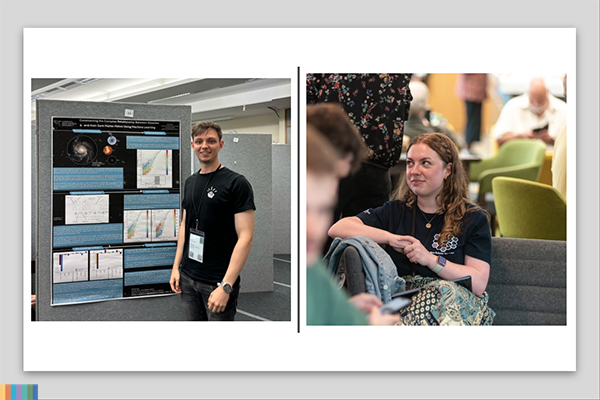LIV.INNO students present work at National Astronomy meeting

LIV.INNO PhD students Emily Costello and Ryan Roberts recently showcased their cutting-edge research at the National Astronomy Meeting (NAM), hosted by the University of Hull. This annual event, organized by the Royal Astronomical Society, brings together hundreds of astrophysicists from institutions across the UK to present and discuss the latest developments in the field. The week-long conference featured a diverse program of talks and workshops, spanning topics from solar and planetary physics to galaxy formation and the large-scale structure of the universe. Emily and Ryan shared their latest research findings with the wider astrophysical community, underscoring the innovative work emerging from the LIV.INNO program.
The week began with an interesting session titled ‘Beyond Astronomy’ which focused on the application of techniques and software from astronomy to solve problems on Earth. Ryan presented his work on AstroPT, an open-source collaborative effort to create a set of GPT-like 'Large Observation Models’ (LOMs) that were trained on 8.6 million DESI galaxy images. The models were trained on the surrogate task of predicting the next patch in a sequence of patches that comprised a galaxy image. It performed this in a self-supervised manner, meaning that the models weren't given a strict objective to learn and instead determined its own way of continually improving its ability to predict the galaxy patches. The largest AstroPT model was 2.1 billion parameters and trained using Liverpool John Moores University’s Prospero supercomputer.
During the talk, Ryan explained that you can successfully scale the LOMs using astronomical data, meaning that astronomical photometry carries rich enough information to continually scale the LOMs (up to a saturation point). The embedding space of the models - notably the larger, more complex models - displayed an understanding of the underlying physics of the galaxies, despite having no prior knowledge or explicit exposure to the physical properties of galaxies. When mapped to a linear probe, it successfully managed to predict galaxy properties such as the stellar mass and magnitudes in different colour bands. It learned this simply as a bi-product of trying to improve at predicting the next patches in galaxy images.
As a case study for applying the model architecture to real-world problems, a similar model called EarthPT applied this technique to Earth-observation data. It had similar success, with a notable use being the ability to retroactively predict a known drought that happened in 2022 in the UK, with the model trained on data that stopped several months before the drought happened. This research was completed as part of Ryan’s LIV.INNO industrial placement at Aspia Space.
Alongside giving a talk based on his work with Aspia Space, Ryan also presented his own research as a poster, titled “Constraining the Complex Relationships Between Galaxies and Dark Matter Haloes Using Machine Learning”. This work focused on utilising a combination of an XGBoost regression model with SHAP, a powerful explainable AI method for retroactively calculating feature importance in machine learning models by utilising probabilistic game theory. This allows for the establishment of the importance evolution of galaxy and halo properties in predicting the circum-galactic mass fraction at fixed halo mass. This utilised the EAGLE and IllustrisTNG simulations as testing environments.
Emily presented her current research in a session focused on unveiling the nature of galaxy clusters through both observations and simulations. Her talk, titled "The Impact of Satellite Black Hole Feedback in Galaxy Groups and Clusters", delved into the role of central and satellite black holes in shaping the distribution of baryons within galaxy group- and cluster-mass haloes. Emily’s work uses two suites of state-of-the-art cosmological hydrodynamical simulations from the BAHAMAS and FLAMINGO projects, developed in collaboration with the Virgo Consortium. Her work sparked interest and discussions among experts in the field, adding to the innovative contributions from the LIV.INNO program at the conference.